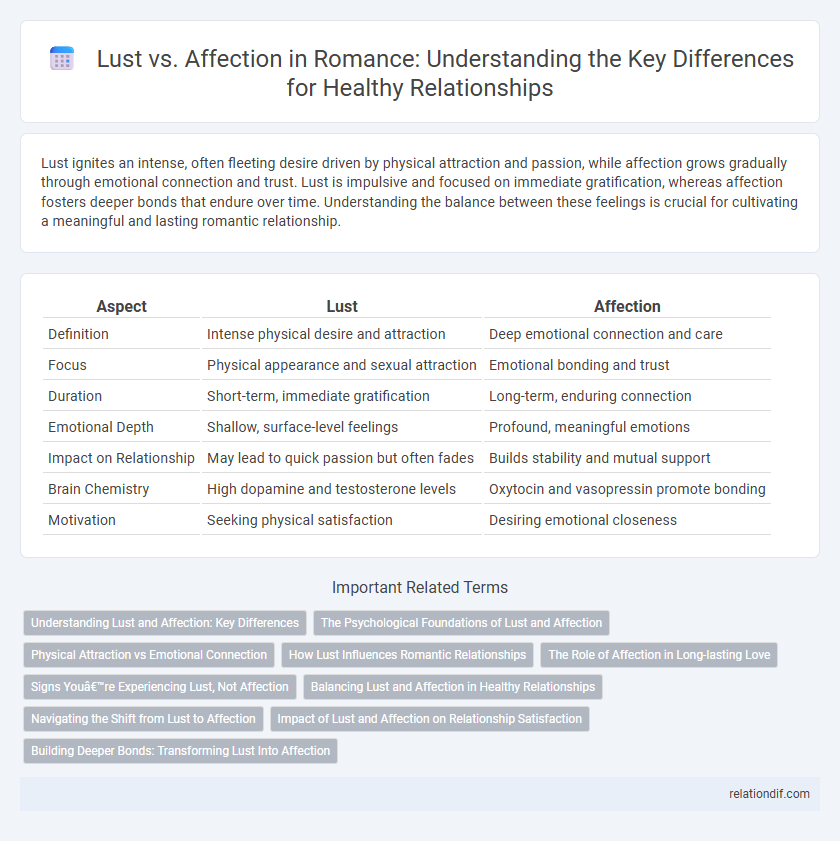Lust ignites an intense, often fleeting desire driven by physical attraction and passion, while affection grows gradually through emotional connection and trust. Lust is impulsive and focused on immediate gratification, whereas affection fosters deeper bonds that endure over time. Understanding the balance between these feelings is crucial for cultivating a meaningful and lasting romantic relationship.
Table of Comparison
| Aspect | Lust | Affection |
|---|---|---|
| Definition | Intense physical desire and attraction | Deep emotional connection and care |
| Focus | Physical appearance and sexual attraction | Emotional bonding and trust |
| Duration | Short-term, immediate gratification | Long-term, enduring connection |
| Emotional Depth | Shallow, surface-level feelings | Profound, meaningful emotions |
| Impact on Relationship | May lead to quick passion but often fades | Builds stability and mutual support |
| Brain Chemistry | High dopamine and testosterone levels | Oxytocin and vasopressin promote bonding |
| Motivation | Seeking physical satisfaction | Desiring emotional closeness |
Understanding Lust and Affection: Key Differences
Lust is characterized by intense physical desire driven primarily by attraction and hormonal impulses, often focused on immediate gratification without deeper emotional connection. Affection, in contrast, involves a nurturing sense of care and emotional warmth that builds trust, intimacy, and long-term bonding beyond mere physical attraction. Understanding these distinctions is crucial for navigating romantic relationships that balance passion with meaningful emotional engagement.
The Psychological Foundations of Lust and Affection
Lust is driven primarily by hormonal responses and primal urges, activating brain regions like the hypothalamus and amygdala to promote physical attraction and immediate gratification. Affection, rooted in oxytocin and vasopressin release, fosters emotional bonding and long-term attachment by engaging the brain's reward system, particularly the ventral pallidum. Understanding these distinct neurochemical pathways highlights how lust and affection serve different evolutionary purposes in romantic relationships.
Physical Attraction vs Emotional Connection
Physical attraction ignites desire through visual and sensory stimuli, fueling lust with intense passion and immediate gratification. Emotional connection, rooted in affection, fosters trust, intimacy, and a deeper bond that sustains long-term romantic relationships. Balancing lust's magnetic pull with genuine emotional connection creates a fulfilling and enduring partnership.
How Lust Influences Romantic Relationships
Lust ignites intense physical desire that can accelerate the initial stages of romantic relationships, often creating a powerful attraction based on appearance and chemistry. This primal drive can sometimes overshadow deeper emotional connections, leading to relationships fueled more by physical gratification than mutual understanding or affection. However, when balanced with genuine affection, lust can enhance intimacy and contribute to a fulfilling and passionate partnership.
The Role of Affection in Long-lasting Love
Affection serves as the emotional foundation that sustains long-lasting love by fostering trust, empathy, and mutual understanding between partners. Unlike lust, which is driven by physical desire and often transient, affection nurtures deeper connections through consistent acts of care and emotional support. Research in relationship psychology highlights that couples who prioritize affectionate behaviors experience greater relationship satisfaction and resilience over time.
Signs You’re Experiencing Lust, Not Affection
Rapid heartbeat, intense physical attraction, and overwhelming desire for immediate intimacy are clear signs you're experiencing lust, not affection. Lust often lacks emotional connection and focuses on surface-level traits such as appearance and sexual chemistry rather than deeper bonds or shared values. Recognizing these signs helps distinguish fleeting temptation from lasting emotional intimacy in romantic relationships.
Balancing Lust and Affection in Healthy Relationships
Balancing lust and affection is essential for sustaining healthy relationships, as lust provides physical attraction and passion while affection fosters emotional connection and trust. Prioritizing both elements ensures intimacy remains vibrant and meaningful, preventing relationships from becoming purely physical or emotionally stagnant. Couples who communicate openly about their desires and feelings create a dynamic where lust enhances affection, leading to deeper mutual satisfaction and long-term bond stability.
Navigating the Shift from Lust to Affection
Navigating the shift from lust to affection involves understanding the transition from intense physical desire to deep emotional connection. This process requires patience, effective communication, and shared experiences that build trust and intimacy beyond initial attraction. Developing affection ensures a more sustainable and meaningful romantic relationship rooted in mutual respect and emotional support.
Impact of Lust and Affection on Relationship Satisfaction
Lust often drives intense physical attraction and short-term excitement, but its impact on long-term relationship satisfaction tends to be limited compared to affection. Affection fosters emotional intimacy, trust, and deep connection, which are critical predictors of sustained relationship happiness and stability. Research shows couples prioritizing affection report higher satisfaction and resilience during conflicts than those primarily motivated by lust.
Building Deeper Bonds: Transforming Lust Into Affection
Lust ignites intense physical attraction, but transforming it into affection paves the way for lasting emotional connections. Building deeper bonds requires nurturing trust, shared experiences, and genuine vulnerability beyond initial desire. This shift fosters meaningful intimacy that sustains romantic relationships over time.
lust vs affection Infographic

 relationdif.com
relationdif.com